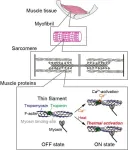(Press-News.org) Studying the brain remains one of the most challenging endeavors in neuroscience. Researchers have explored various methods for live imaging and stimulation of deep brain activity. One such method is multiphoton excitation using pulsed infrared (IR) light. This type of light is weakly absorbed by tissues and can penetrate through the bone and deep into organs like the brain. However, it has its limitations to produce focused images and to control cellular activity with precision. To overcome this, scientists have been exploring three-photon excitation with ultrafast pulsed IR light, to achieve whole cortex imaging and the observation of neuronal activity. Yet, until now, in vivo neuronal stimulation using three-photon excitation had not been reported.
A groundbreaking study, led by the Institute for Bioengineering of Catalonia (IBEC) in collaboration with the ICFO – Institute of Photonic Sciences, both members of BIST, has introduced the first method for controlling brain activity in living organisms using drugs activated by three-photon excitation and mid-infrared light. This method is based on activating a specific receptor for acetylcholine, a vital neurotransmitter involved in various brain processes such as learning, attention, and memory.
To achieve this, researchers utilized PAI, a light-responsive molecule previously developed at IBEC, employing the lowest drug concentration and the longest photoactivation wavelength ever recorded.
The study, published at Angewandte Chemie journal, was led by Dr. Pau Gorostiza, ICREA Research Professor, member of CIBER-BBN and Leader of the Nanoprobes and nanoswitches group at IBEC and by Dr. Pablo Loza-Álvarez, head of the Super resolution microscopy and Nanoscopy (SNL) lab at ICFO.
“The novelty of these results lies in the demonstration that the activity of drugs can be controlled with IR light, and that most of the photoswitchable ligands previously used in photopharmacology with ultraviolet and visible light are amenable to three-photon excitation using mid-infrared light, which is gentler on tissues.” Explains Gorostiza.
“Plus, this technique, being IR illumination, provides the opportunity to penetrate deep within the tissue with submicrometric resolutions in all three dimensions. In simple terms, it means we can pinpoint the activation right at the laser beam’s focal point, illuminating it externally through the skull.” Adds Loza-Álvarez.
These results showcase the potential of three-photon pharmacology and open up new horizons for fundamental research in neurobiology and the development of light-based neuromodulation therapies.
The power of light
Light can be harnessed to enable targeted drug action within specific areas of the body through photopharmacology. This innovative approach involves modifying the chemical structure of a drug by adding a light-activated molecular switch, ensuring the drug activates only when exposed to a particular color of light.
In previous research, IBEC scientists tried to activate PAI using one-photon and two-photon excitation with limited reversibility and control in vivo. In their recently published paper, researchers turned to longer wavelength IR light and theoretical calculations to enhance the activation of PAI through multi-photon excitations. These calculations, performed by the laboratory of Josep Maria Lluch and Jordi Hernando at the Autonomous University of Barcelona suggested that three-photon excitation could be more efficient than the two-photon alternatives, and that the principle could be widely applicable.
Subsequently, the researchers conducted in vivo experiments to validate these theoretical predictions. They used zebrafish larvae genetically engineered to express a fluorescent calcium indicator. Neural activity leads to rapid fluctuations in intracellular free calcium, which is why calcium indicators are commonly employed to visualize neural activity.
This experimental setup allowed them to observe and analyze alterations in calcium levels when the brain was exposed to light stimulation through three-photon excitation: “The first time we saw the brain responses we were really impressed. We administered the PAI compound in its inactive form, which was uptaken by the zebrafish brain, and when we excited it with the three-photon flashes, the entire brain lit up. Using our setup, we could clearly see the PAI activation as changes in brain activity,” highlights Rosalba Sortino, first author of the study and recently doctorated researcher from Gorostiza’s group at IBEC.
In their future work, researchers plan to apply even shorter and more focused stimulation to study these endogenous responses in detail.
END
Researchers induce brain activation using infrared light-controlled drugs
This cutting-edge technique activates a specific neurotransmitter receptor using mid-infrared light, which can penetrate deep into tissue and offers unparalleled pharmacological and spatiotemporal precision in three dimensions.
2023-10-25
ELSE PRESS RELEASES FROM THIS DATE:
People with severe mental illness at 50 per cent higher risk of death following COVID-19 infection
2023-10-25
New research from King’s College London has found that in the UK people with severe mental illness were at increased risk of death from all causes following COVID-19 infection compared to those without severe mental illness.
Published in the British Journal of Psychiatry, the study investigated the extent to which having severe mental illness, which includes schizophrenia and psychosis, increased the risk of death during the first two waves of the COVID-19 pandemic.
Researchers at the Institute of Psychiatry, Psychology & Neuroscience (IoPPN) and ESRC Centre for Society and Mental Health analysed data from over 660,000 ...
Closing digital skills gap could spur global economic growth by $11.5 trillion
2023-10-25
This significant lack of expertise means firms are not fully embracing the automation revolution, costing businesses valuable time and money.
Intelligent Automation: Bridging the Gap between Business and Academia delves into how companies and universities can use intelligent automation to address the challenges preventing the workforce from prospering amid the Fourth Industrial Revolution.
(NEW YORK – October 16, 2023) The economic benefits of intelligent automation are vast, potentially totaling trillions of dollars in economic growth, according to research in a new book.
Businesses and organizations ...
Our favorite bittersweet symphonies may help us deal better with physical pain
2023-10-25
Research has shown that music might be a drug-free way to lower humans’ pain perception. This decreased sensitivity to pain – also known as hypoalgesia – can occur when pain stimuli are disrupted between their point of input and where they are recognized as pain by the conscious mind. In a new study, researchers in Canada have examined what type of music helps to dampen pain perception.
“In our study, we show that favorite music chosen by study participants has a much larger effect on acute thermal pain reduction than unfamiliar relaxing music” said Darius Valevicius, a doctoral student at the Université ...
New evidence explains how warming-up enhances muscle performance
2023-10-25
Osaka, Japan – Everybody knows the importance of warming up your muscles before a workout. But what is actually going on when we warm our muscles up, and are all muscles the same? You might be surprised to find out that the science behind this routine activity hasn’t always been clear.
Now, in a study recently published in the Journal of General Physiology, a multi-institutional research team, led by Osaka University, The Jikei University School of Medicine and National Institutes for Quantum Science and Technology, has revealed how heating affects the contraction of different muscles, and how this might benefit populations in need of improved ...
KERI's thermoelectric technology, key to space probes, attracting German attention
2023-10-25
Drs. SuDong Park, Byungki Ryu, and Jaywan Chung of the Korea Electrotechnology Research Institute (KERI) developed a new thermoelectric efficiency formalism and a high-efficiency multistage thermoelectric power generator module. This innovation can boost nuclear battery performance, crucial for space probes, and has attracted attention from the German Aerospace Research Institute.
A Radioisotope Thermoelectric Generator (RTG), known as a thermoelectric-based nuclear battery, is a dependable power ...
Undiagnosed: More than 7 million Americans unaware they have mild cognitive impairment
2023-10-25
By Katharine Gammon
For many people, forgetting your keys or struggling to plan tasks can seem like a normal part of the aging process. But those lapses can actually be symptoms of something more serious: mild cognitive impairment, or MCI, which could be an early sign of Alzheimer’s disease.
Unfortunately, most people who have MCI don’t know it, so they’re unable to take advantage of preventive measures or new treatments, such as a recently approved drug for Alzheimer’s disease, that ...
GigXR partners with NUS Medicine to deliver holographic clinical scenarios for gastroenterology training
2023-10-25
GigXR, Inc., a global provider of holographic healthcare training, announced today its partnership with the Yong Loo Lin School of Medicine, National University of Singapore (NUS Medicine), one of the world’s leading medical schools, to introduce a new gastrointestinal module for the award-winning HoloScenarios application. Created to better prepare medical and nursing students in diagnosing and treating acute gastrointestinal diseases, HoloScenarios: Gastrointestinal delivers evidence-based, robust clinical simulations that present hyperrealistic holographic simulated patients and medical equipment to be used in any physical learning environment, ...
Sylvester Comprehensive Cancer Center tipsheet for Oct. 2023
2023-10-25
Cancer Leadership
Sylvester Leader Named BioFlorida’s ‘Researcher of Year’
Stephen D. Nimer, MD, Sylvester Cancer director, has been named Researcher of the Year by BioFlorida, an association for the state’s life sciences industry. BioFlorida represents 8,600 companies and research organizations in biopharmaceuticals, medical technology, digital and health systems. It honored Nimer for his groundbreaking research in adult leukemia which has contributed to transforming patient care. For details, visit the InventUM blog.
Pioneering Sylvester Physician Elected to Neuro-Oncology Board
Macarena de la Fuente, ...
UC Riverside physicist awarded National Medal of Science
2023-10-25
RIVERSIDE, Calif. -- Physicist Barry C. Barish, a distinguished professor of physics and astronomy at UC Riverside, was awarded the National Medal of Science by President Joe Biden at a ceremony held at the White House today. Established in 1959 by the U.S. Congress, the National Medal of Science is the highest recognition the nation can bestow on scientists and engineers.
The President’s National Medal of Science is given to individuals “deserving of special recognition by reason of their outstanding contributions in biology, computer sciences, education sciences, engineering, geosciences, mathematical and physical sciences, and social, behavioral, and economic ...
Daily 20-25 mins of physical activity may offset death risk from prolonged sitting
2023-10-25
Clocking up just 20-25 minutes of physical activity every day may be enough to offset the heightened risk of death from a highly sedentary lifestyle, suggests research published online in the British Journal of Sports Medicine.
But higher daily tallies of physical activity are linked to a lower risk, irrespective of the amount of time spent seated every day, the findings show.
In developed nations, adults spend an average of 9 to 10 hours every day sitting down—mostly during working hours. And a highly sedentary lifestyle is associated with a heightened risk of death, explain the researchers.
Much of the ...
LAST 30 PRESS RELEASES:
Autonomous AI agents developed to detect early signs of cognitive decline
Study finds ocean impacts nearly double economic cost of climate change
Increased deciduous tree dominance reduces wildfire carbon losses in boreal forests
Researchers discover how a respiratory bacterium obtains essential lipids from the human body and targets fat-rich tissues
Locust swarms destroy crops. Scientists found a way to stop that
More resources and collaboration needed to support prevention and treatment of obesity
Two types of underconfidence linked to anxiety and gender
Insects are victims too: Global study shows impacts of invasive alien species on populations
Pioneering natural, degradable polymer capsules
Forestry is becoming digital and automated
Maternity baby deaths much higher in northern England than in the South
Mosquitoes’ thirst for human blood has increased as biodiversity loss worsens
The stop-smoking medication varenicline may also work for cannabis use disorder
Potential new treatment for sepsis
Study reveals how many hours of video games per week might be too many
Electrospinning for mimicking bioelectric microenvironment in tissue regeneration
Home fingertip oxygen monitors less accurate for people with darker skin tones
Six weeks in a cast no less effective than surgery for unstable ankle fractures
Precautionary approach to alcohol-free and low alcohol drinks needed to protect public health, say experts
Gas-atomized Ca–Mg alloy powders produce hydrogen simply by adding water — high-efficiency hydrogen generation at room temperature
British redcoat’s lost memoir reveals harsh realities of life as a disabled veteran
World-leading rare earth magnet recycling facility launches in UK
Corday Selden selected for the Oceanography Society Early Career Award
MIT chemists determine the structure of the fuzzy coat that surrounds Tau proteins
Same moves, different terrain: How bacteria navigate complex environments without changing their playbook
Severe weather is deadly for vulnerable older adults long after the storm ends, study finds
Expert panel highlights opportunities for improving cancer studies
Hearing aid prescriptions not associated with changes in memory and thinking
Seth Zippel selected for The Oceanography Society Early Career Award
Jeremy Horowitz selected for The Oceanography Society Early Career Award
[Press-News.org] Researchers induce brain activation using infrared light-controlled drugsThis cutting-edge technique activates a specific neurotransmitter receptor using mid-infrared light, which can penetrate deep into tissue and offers unparalleled pharmacological and spatiotemporal precision in three dimensions.



